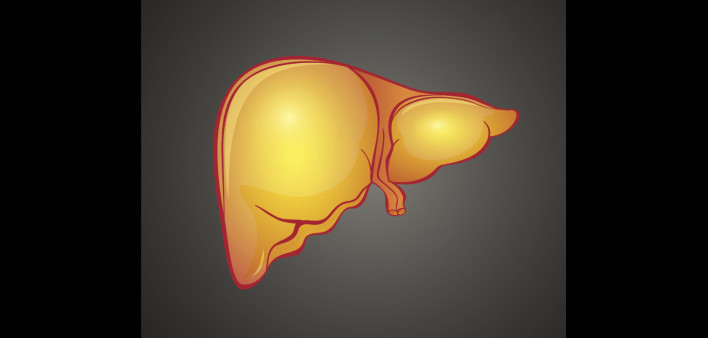More than a third of people living with HIV had fatty liver disease in a cohort study in Germany, and a substantial number had moderate or worse fibrosis, researchers reported in the journal AIDS. Noninvasive tests can be used to evaluate fatty liver disease in HIV-positive people, helping to identify those who might benefit from lifestyle changes to improve their metabolic health.
Non-alcoholic fatty liver disease (NAFLD) and its more severe form, non-alcoholic steatohepatitis (NASH), are responsible for a growing burden of advanced liver disease worldwide. In many cases, liver fat accumulation is associated with obesity and diabetes, so it is sometimes referred to as metabolic-associated fatty liver disease, or MAFLD. Over time, the buildup of fat in the liver triggers inflammation, which can lead to fibrosis (scarring), cirrhosis and liver cancer. With no effective approved treatment, management relies on lifestyle changes such as exercise and weight loss.
The prevalence of fatty liver disease is increasing in the United States and worldwide in association with a global rise in obesity. Epidemiological studies suggest that around one third of people in the United States have NAFLD. Among people living with HIV, liver disease is a leading cause of death. In part, this is attributable to chronic hepatitis B and C and alcohol-related liver disease, but HIV-positive people are also prone to fatty liver disease.
As described in a Current Opinion in HIV and AIDS review of liver fibrosis among people with HIV, hepatitis C is receding as a cause of progressive liver disease, but fibrosis can persist even after successful antiviral treatment. Antiretroviral medications that are dually active against HIV and hepatitis B virus can stabilize liver disease. Both HIV infection itself and certain antiretroviral medications are associated with metabolic abnormalities. Newer antiretrovirals such as integrase inhibitors may have limited intrinsic liver toxicity, the review authors wrote, but they do appear to increase weight, which may lead to liver steatosis.
In an effort to learn more about fatty liver disease in people with HIV, Maurice Michel, MD, and colleagues from University Medical Center in Mainz, Germany, used Using noninvasive tests to assess the presence of liver steatosis (fat accumulation) and fibrosis among 282 HIV-positive adults seen at the university’s metabolic liver research program.
The study authors measured controlled attenuation parameter (an indicator of steatosis), liver stiffness (and indicator of fibrosis) and ALT and AST liver enzyme. Liver biopsy is considered the “gold standard” for diagnosing steatosis and fibrosis, but it is not feasible as a screening tool, they noted. They calculated FAST scores using an equation that combines FibroScan steatosis and fibrosis results and AST levels.
Most participants (70%) were men, and the median age was 51. The median CD4 count was high, at 723, but just 60% had an undetectable HIV viral load. Only 3% had active hepatitis C, and less than 2% had hepatitis B. Metabolic risk factors were common. A third had overweight, 16% had obesity, 10% had diabetes and 30% had high blood pressure. Less than 10% reported heavy alcohol use.
One hundred people (36%) were found to have liver steatosis. Seventy-five people (27% of the whole cohort and 75% of those with steatosis) met the criteria for NAFLD. About 5% met the criteria for alcohol-related liver disease, but some were missing data on alcohol consumption.
Nineteen people (7%) had moderate or worse fibrosis (stage F2 or higher). Based on the FAST score, 32 (12%) had a cutoff greater than 0.35, indicating substantial steatosis and fibrosis. Within this subgroup, 28 were classified as having NASH, two had alcoholic steatohepatitis and two were unclassified.
More than one third (38%) of the people with NAFLD had metabolic syndrome and its associated risk factors. Body mass index (BMI) was higher, waist circumference was larger and obesity was more common among people with NAFLD. People with moderate or worse fibrosis were older, on average, and had been living with HIV longer, but other HIV parameters, such as viral load and CD4 count, were not significantly different. A numerically higher proportion of people with NAFLD used tenofovir alafenamide (TAF) versus the older tenofovir disoproxil fumarate (TDF), but the researchers suggested this might be because doctors are more likely to prescribe TAF to patients with metabolic risk factors that could be detrimental for kidney or bone health.
In a multivariate analysis, waist circumference was the only independent predictor of liver steatosis, and diabetes was the only predictor of moderate or worse fibrosis. Diabetes and elevated ALT were independent predictors of having a FAST score greater than 0.35. HIV parameters showed no association with NAFLD, fibrosis or a high FAST score.
The researchers noted that other studies have found that BMI is the strongest predictor of fatty liver disease. However, waist circumference may be a better surrogate marker for visceral fat surrounding the abdominal organs, and central obesity—rather than weight or BMI—is part of the definition of metabolic syndrome. They added that central obesity in people with HIV may also be a result of lipodystrophy, but this has become less common with modern antiretroviral treatment.
“NASH with significant fibrosis is highly prevalent among people with HIV,” the study authors concluded. “The FAST score may be helpful to identify patients at risk for significant liver disease.”
“[T]his study highlights the applicability of a noninvasive test to detect NASH with significant fibrosis, and thus, helps to identify patients that are metabolically unhealthy,” they wrote. “Addressing these factors may improve the metabolic health and prevent the progression to more severe chronic liver diseases in people with HIV.”
Click here to read the study.
Click here for more news about fatty liver disease.







Comments
Comments